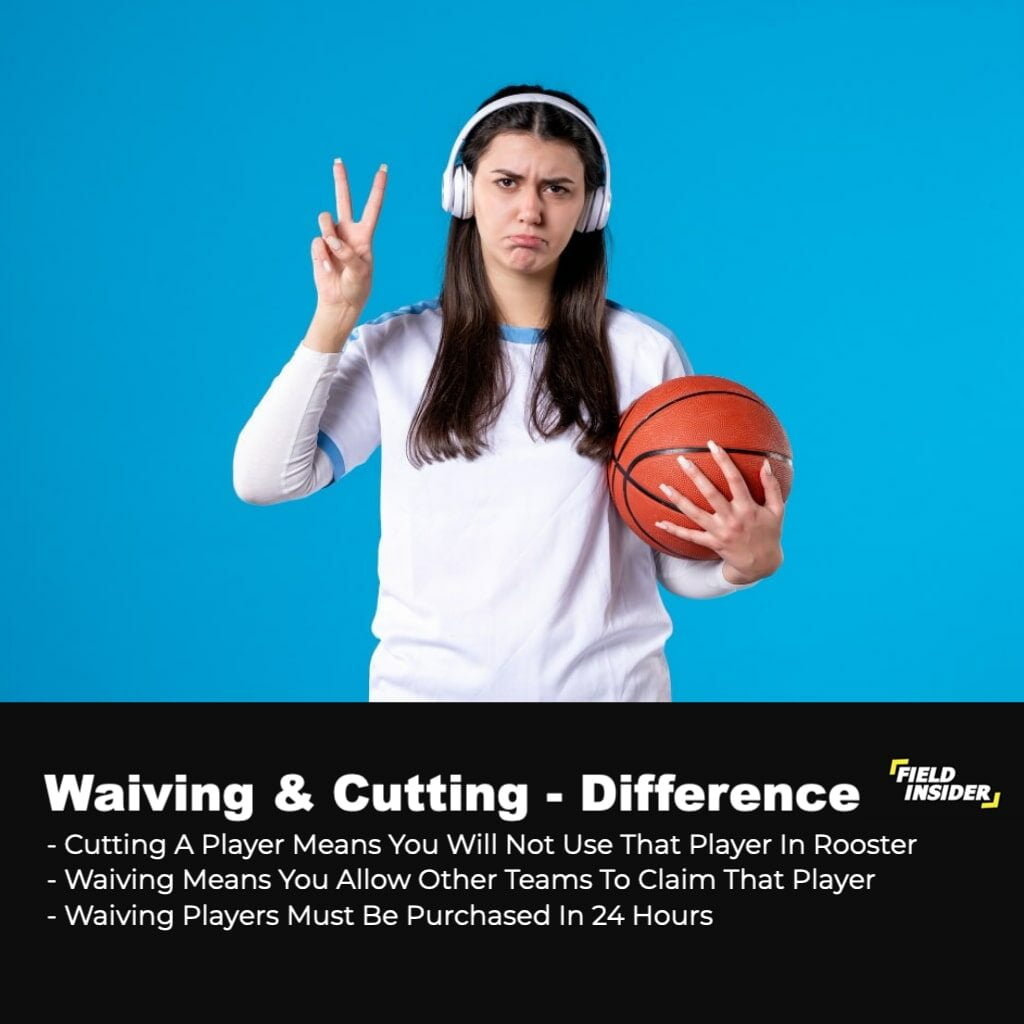Waiving A Basketball Player In NBA: Waiving & Cutting
The NBA waives a player when a team no longer wants to have them on their roster. The waiving procedure is different from the cutting process and is governed by a set of very precise guidelines. This blog post will go over the NBA’s process for waiving players. Moreover, we will be explaining what occurs if they are not claimed by a different team.
What Are Waivers in the NBA?
When waiving a player in the NBA, it is referred to as “stretching”. You are not just grabbing your things, pack up, and leaving at the end of this process. Once an NBA team places a player on waivers. other teams may sign them as free agents, this is referred to as waiving.

What Happens When a Player is Waived in the NBA?
When a player is waived they become free agents. They can sign with any team in the NBA. Or they may choose to play overseas for a couple of years. And then return to the NBA when their contract has ended.
All teams have an equal chance to sign a player once they clear waivers. But, if another club waives them off within 24 hours, that previous claim will take priority over any further waiver requests from other teams. The 1st team to claim will have the top priority.
However, if nobody else tries to claim them. The initial team that waived them then has first choice to claim them again if they so want. Teams only have 48 hours to decide whether or not to release a statement that they want to acquire a player.
NBA Rules on Waiving Players
- A waiver request can only be submitted between July 23rd and January 15th every year.
- Every season, each of the 30 league teams has one opportunity to claim a player that has been waived by another team(s).
- Consider a scenario in which Team A had placed just one player on waivers by January 15th. The other team could then take that player under their own ownership. And during this time, the other 29 teams wouldn’t have a chance to compete against them.
- After January 15th has passed in any season, NBA teams cannot place players on waivers until after the end of the regular season (May 31st).
- Any waiver requests submitted between these two times will be reviewed by all 30 league teams over the course of 24 hours; from the lowest to the finest record, in that order.
- If, within 24 hours, more than one team makes a claim on the same waived player’s contract; then, the worse win-loss records are given priority first. This gets better over the course of those 24 hours as you climb the list according to win-loss statistics.
- If no team waives a claim on the player then they are said to have “cleared waivers”. This means that no other teams tried to acquire you while on waivers and the player is a “free agent.”
- Teams not claiming a player doesn’t necessarily mean that they do not want their services. Sometimes it may mean that they do not want to absorb the current remaining contract.
- That’s why there are some teams who wait for a player to “clear waivers” before they try to acquire a player. And it often happens if only no other team tries to make a claim on the player.
- A waiver notice includes all terms of an NBA contract — salary, years remaining, etc., but does not include bonus clauses.
- If no other team placed a claim wihtin 48 hours since a player is waived, then that certain player will now be an unrestricted free agent.
These are some very specific rules when it comes to waiving a basketball player in the NBA! It is important to understand how this process works. As the waiving process is different from cutting a player in the NBA.
What’s the Difference Between Waiving and Cutting a Player in the NBA?
With reference to the NBA, the phrases waiving and cutting are occasionally used synonymously. They do, however, mean different things.
In the NBA, cutting a player indicates that you will no longer utilize them on your roster. While a player who has been waived by one team is available for 24 hours to teams in other leagues.
So, the following are the primary distinctions between waiving and cutting a player in the NBA:
- Waiving a player in the NBA means that you are allowing other league teams to pick them up. And use them on their roster;
- Cutting a player in the NBA is no longer using them as part of your own team’s active roster.
- Waiving players allows for more time than just 24 hours before they must be claimed by another team. Or else lose waiver priority over those who waive later within those first 24 hours;
- Cutting does not allow for this extended period because it immediately removes them from your ranks without any chance at playing with any other league teams.

Do Waived Players Still Get Paid?
In the NBA, a player’s full contract is still paid even after they are waived. The team that initially waived them, however, is no longer liable for covering the remainder of their salary if another team subsequently claims them off waivers. The team that waived the player will not be compensated in any way.
Although it is possible for the team waiving the player to pay the player’s salary in order to keep them on their roster, this is extremely uncommon in the NBA of today.
The total amount that a waiving team may spend on free agency acquisitions or trades throughout the season (no more than $100,000 each year) will include any money it pays out to another league team in exchange for one of its players.
The owners of both clubs have added more limitations and rules to this! This usually depends on the contract parameters that sometimes is not publicly announced.
Can an NBA Player Request to be Waivered?
Yes, waiving players in the NBA may be a player’s option. If they believe their team won’t need them going forward or if they want a bigger role on another league team, they might ask to be waived.
Players frequently consider removing themselves from a roster when it becomes evident they won’t play for a specific team any longer, either due to decreased playing time or a lack of interest from other teams in signing them.
Moreover, this occurs before any exchange in which waiving may take place first (before being traded).
Waiving a basketball player may also mean that his services are no longer wanted for the team. To properly compensate the player, it is done by paying off his contract completely or waiving him with a buyout.
No Penalties
This is the only instance in which waiving a player in the NBA is free of any fines or repercussions! If the waived player is picked up by another league team, they will be responsible for his future overpayments just as if they had cut him from their roster in the first place.
This also relates to how waived players are compensated during this process; anything over what the teams that waived the players were paid for doing so went toward paying the salaries of the teams that ultimately selected the players, with the waiving teams still receiving a portion (if more than $100,000).
Why do NBA Teams Trade for Players and then Waive Them?
This is a great question! Let’s assume that there is this awesome player who was playing on another team in the NBA, but then they were waived because of their financial constraints.
If you trade for this waiving player and waive them afterwards, then it helps your win/loss record — which improves your rankings when waiving players during these 24 hours (July 23rd to January 15th).
NBA teams and general managers are all about assets! Teams that feel like they can’t compete for the playoffs may trade a relevant player to get future draft picks back. This is usually called a “rebuilding” phase if the team decides in the middle of the season to focus on building the future and letting go of the present players.
Hence, trading can be advantageous if you want to raise your draft position or simply want extra time to think things over before deciding whether or not to keep a player.

Conclusion
At the end of the day, waiving a basketball player in the NBA is all about financial considerations and whether or not your own roster needs are more important than another league’s teams’ rosters.
The NBA’s waiver policy can be very difficult to comprehend, so we hope our blog post has helped to clear up any misunderstandings. Moreover, we would love to hear from anyone who needed assistance with their waiver claims and how our procedure helped! Once more, thank you for reading our blogs!








